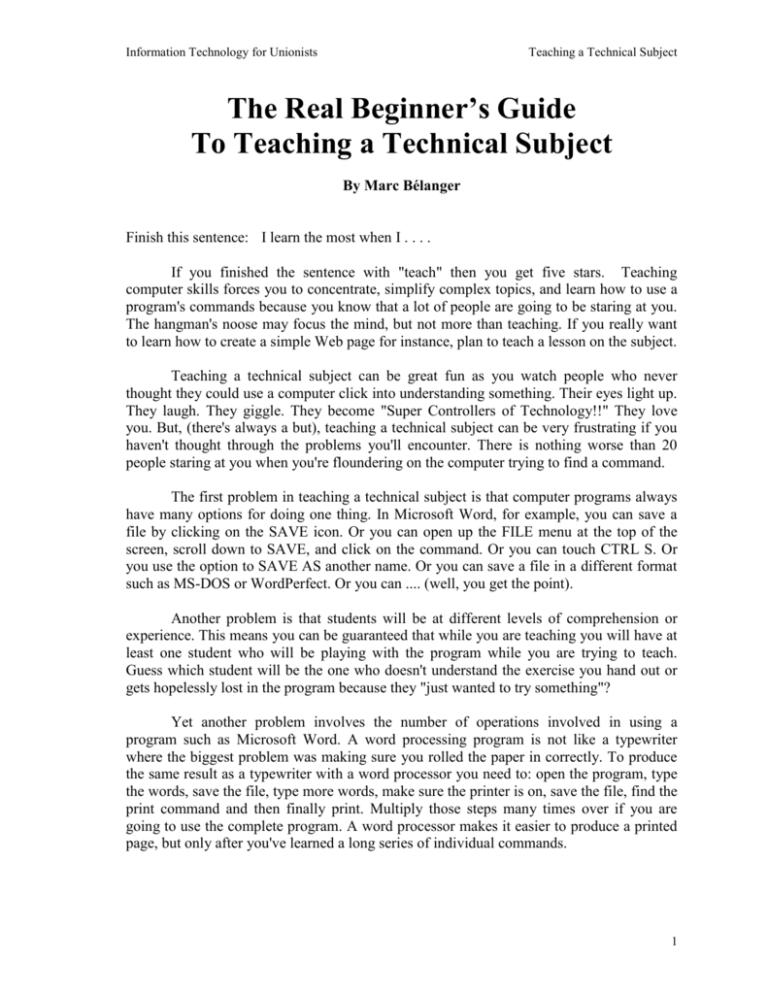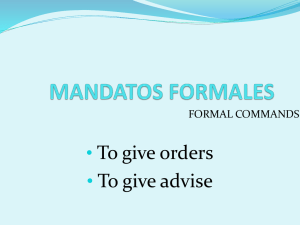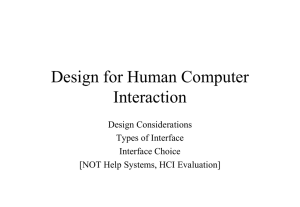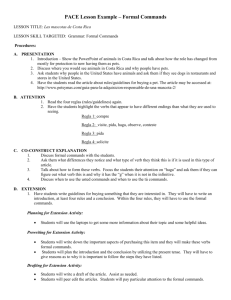MS Word
advertisement

Information Technology for Unionists Teaching a Technical Subject The Real Beginner’s Guide To Teaching a Technical Subject By Marc Bélanger Finish this sentence: I learn the most when I . . . . If you finished the sentence with "teach" then you get five stars. Teaching computer skills forces you to concentrate, simplify complex topics, and learn how to use a program's commands because you know that a lot of people are going to be staring at you. The hangman's noose may focus the mind, but not more than teaching. If you really want to learn how to create a simple Web page for instance, plan to teach a lesson on the subject. Teaching a technical subject can be great fun as you watch people who never thought they could use a computer click into understanding something. Their eyes light up. They laugh. They giggle. They become "Super Controllers of Technology!!" They love you. But, (there's always a but), teaching a technical subject can be very frustrating if you haven't thought through the problems you'll encounter. There is nothing worse than 20 people staring at you when you're floundering on the computer trying to find a command. The first problem in teaching a technical subject is that computer programs always have many options for doing one thing. In Microsoft Word, for example, you can save a file by clicking on the SAVE icon. Or you can open up the FILE menu at the top of the screen, scroll down to SAVE, and click on the command. Or you can touch CTRL S. Or you use the option to SAVE AS another name. Or you can save a file in a different format such as MS-DOS or WordPerfect. Or you can .... (well, you get the point). Another problem is that students will be at different levels of comprehension or experience. This means you can be guaranteed that while you are teaching you will have at least one student who will be playing with the program while you are trying to teach. Guess which student will be the one who doesn't understand the exercise you hand out or gets hopelessly lost in the program because they "just wanted to try something"? Yet another problem involves the number of operations involved in using a program such as Microsoft Word. A word processing program is not like a typewriter where the biggest problem was making sure you rolled the paper in correctly. To produce the same result as a typewriter with a word processor you need to: open the program, type the words, save the file, type more words, make sure the printer is on, save the file, find the print command and then finally print. Multiply those steps many times over if you are going to use the complete program. A word processor makes it easier to produce a printed page, but only after you've learned a long series of individual commands. 1 Information Technology for Unionists Teaching a Technical Subject Then there's the glazed-eye problem. While most of your students are trying to understand and follow your instructions as you introduce the program, there will always be at least one who didn't understand a crucial step and is starting to get lost. And will they tell you they're starting to get lost? No. Never. People in groups act like people in groups. They are under pressure to act like the rest of the group. So they won't say anything. They will pretend they are like everybody else in the group and that they understand exactly what you are saying. But eventually they will have to admit they are lost. And then just try to figure out where in the series of commands they got lost. Good luck. The solution to the glazed-eye problem is the stare, but more about that later. There are, of course, many more problems involved in teaching a technical subject, but let's concentrate on the ones I've listed above for now. But first I have to tell you about the Golden Rule Of Demonstrations: The Golden Rule of Demonstrations is that no matter how well you've practised the demonstration, something will go wrong. Sorry. Get used to it. Remember: the word demonstration comes from the old Greek words for DEMONS and FRUSTRATION. If one day Athena, the goddess of technology, smiles and let's you finish a demonstration without a problem she'll frown another day. Count on it. She's like that. The solution is: Tell your students about the Golden Rule right from the start. That way they'll expect something to go wrong. If everything goes smoothly, they'll think you're a genius. If something goes wrong, they'll understand it's the Golden Rule coming into play. Either way, you win. Now about problem number one: the multiple options in a program. The solution is simple: Don't tell anybody about the options! Choose a path of commands and teach it like it's the only path. After the students have learned the basic set of commands you can introduce the other options. For example, teach them to click on the SAVE icon, first. Only after they've got that figured out (and they think it's the only way) then show them the other paths (such as through the FILE command at the top of the screen). Some students will begin to use the other options but most will stick to the basic path the you first taught and they’ll thank you for it. (If you don't believe in this approach, the next time somebody asks for directions try giving them all the alternative routes at the same time. They won't thank you.) Problem number two: students playing with the computer as you're introducing the program Again, the solution is simple: Turn the monitors off! Not the computers, just the monitors. Walk around the room and make sure everybody has their monitor shut down. A monitor is like a television: it grabs your attention; it forces you to look at it. With the monitors shut down you are more likely to get, and keep, your students' attention. Once you are ready to have the students try an exercise they can turn their monitors back on. (Careful now: there will always be at least one student who hears other voices and will want to shut off the computer, not the monitor, and that can cause problems. Hold your finger in the air and then show them how to push the monitor's on/off button. If you smile and make a joke of it they won't think you're treating them like children; they'll laugh and follow your example. 2 Information Technology for Unionists Teaching a Technical Subject Problem number three: the number of steps it takes to do something in a computer program. The solution is as easy as one, two, three. Teach blocks of commands numbered 1, 2, 3, 4 and so on. And keep the blocks small. Don't try to teach a long series of commands for entering a word processing program, typing paragraphs, naming. the file, saving the file, running a spell check, printing the file and exiting. Somebody will get lost; guaranteed. For example, the very basic, introductory operations for using Microsoft Word are: 1. 2. 3. 4. 5. Click on the icon to start the program. Type ONE phrase or sentence Click on the save icon Name the file Click on the exit icon If they get that into their heads, which they will, they will have learned. Then you can go on to teach other numbered building blocks - just remember to keep them short. Keeping the instructions short allows the students to learn basic operations quickly. But just as important, it helps you help somebody when they get lost. You may think this is ridiculously simple, even insultingly simply, but remember you are not doing one-on-one tutoring. You are trying to teach while co-ordinating a lot of people through a technical operation. If even 25% of them get lost, what are you going to do? Losing control at this point is not fun. Which brings us to a related point. Yes, we all believe in teaching students to think creatively. But learning a technical subject is no time for creativity. You can use the program creatively, but learning how to save a file is no time for brainstorming. File saving, is file saving; printing is printing. Give your students exact numbered steps (all the steps, even the number of clicks) and they'll learn much faster. You can talk about the concept of technology as creative art another time. Ah yes, I can see the eyes glazing over. It's time for the stare. Students who are lost, or more important, starting to get lost in a technical subject, have a 'confusion-film' covering their eyes. They don't know yet that they are lost; they're just confused. The solution is to stare into their eyes and ask gently: "Do you understand?" Their first reaction will likely be to nod their heads. But you can see the glaze. Ask again: "Are you starting to not understand?" That will usually do it. Admitting that you are starting to not understand is easier than admitting you don't understand - especially in front of a group of people. It's important to catch people as they are starting to not understand because it is very difficult to go way back to beginning of the class to find out where you lost somebody. Taking the time to clear up confusion at the start is much less time-consuming than waiting until the end of the exercise where the possibilities for getting lost have multiplied. Technology teaching is sometimes frustrating, but it's always rewarding as you watch people learn. And the best part is: you learn as much, if not more, than the students. 3 Information Technology for Unionists Teaching a Technical Subject 4






